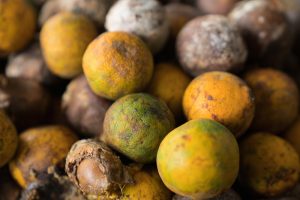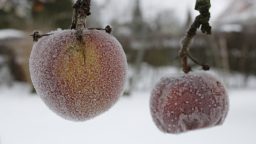Growing up, one of my favorite things to read were the Laura Ingles Wilder books. Not only were they entertaining, but she also went into great detail on how their food was grown or raised, butchered or harvested and then processed to keep all winter long.
Thanks to modern conveniences, most of us don’t really need to take these steps to ensure a comfortable winter, even on a homestead with electricity and appliances. However, it doesn’t hurt to prepare for a worst-case scenario to ensure you won’t get caught during a bad winter storm or power outage.
Fortunately, when proper measures are taken, many foods can be kept all winter long.
Fruits and Veggies
For fruits and vegetables, storage areas should be cool and dark with moderate humidity and a consistent temperature of 40o. When planning a homestead or other remote living location, a root cellar is a good addition for long-term storage. In other homes, a cooler area of a basement or an attached garage can work.

Stock a cellar as late in the fall as possible. Cure vegetables like potatoes, winter squash, and onions in warmer areas before moving them to the cold storage areas. For other items, chill in the fridge before moving to the cellar areas.
Many root cellar veggies store better when some dirt is still on them. If you’ve harvested your own or stocked up from a local farmer’s market, shake or rub the excess dirt off instead of washing them.
Know What Your Food Needs to Last
Squash should be stored in shallow containers or left on shelves as they are. Items like garlic and onions are best kept in mesh bags or open boxes so they can breathe. Potatoes must be kept in complete darkness to prevent the skin from going green.
Avoid piling vegetables together, this generates heat and can lead to them spoiling. Try to spread them out as much as possible and rotate them for even exposure.
Apples can be stored for months in a box and can be piled more than others. This will actually assist them by maintaining humidity to keep them crispy.
Avoid Spoilage
It’s true that one bad apple can spoil the whole barrel, and that doesn’t just apply to apples. Handle your fruits and vegetables carefully as even the slightest bump can create an invisible bruise and begin the decomposition process.
In any storage areas that don’t have built-in climate control, the driest, warmest air will be near the ceiling while more-humid air is nearer the floor and farthest from the door. Keep this in mind as you plan where you will store your produce.
Inspect your stores regularly and immediately remove any soft or rotten items before they can affect the rest.

Keeping Meat
If you are really into the store and save idea, consider smoking and storing your own meats.
Whether you’ve gone hunting, or gone in with a friend and purchased a whole cow, being able to have a portion of that ready to go without relying on the use of a freezer can be a great idea.
Used for millennia by some of the oldest civilizations for long-term storage, smoking creates an acidic coating on the meat that prevents bacteria from cultivating. It also dehydrates the meat, making it less hospitable for bacteria to breed.
So, come late summer and early fall, start planning on what you can stock up on for winter storage. Not only will this provide you with an emergency supply of food when needed, it is also a great way to keep eating local organic food all year round whether it comes from your own garden or the local farmers market.



